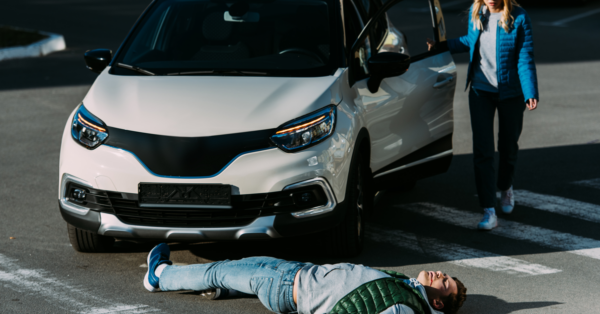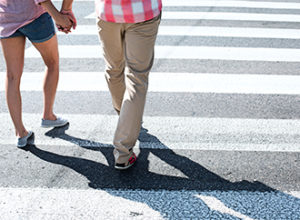
Indiana and other major cities across the country are redesigning their streetscapes to better accommodate pedestrians. This follows the revelation that serious accidents involving pedestrians have been on the rise for years.
On average, a pedestrian is killed every two hours and injured every seven minutes in traffic crashes, based on sobering statistics from the National Highway Traffic Safety Administration. Fourteen percent of all traffic fatalities and an estimated 3 percent of those injured in traffic crashes are pedestrians.
Table of Contents
- 1 What Are the Laws on Pedestrian Right-of-Way in Indiana?
- 2 Do Pedestrians Always Have the Right-of-Way in Indiana?
- 3 When Do Pedestrians Have the Right-of-Way If They Are Not in a Crosswalk?
- 4 What Are Indiana’s Pedestrian Crosswalk Laws?
- 5 Is Jaywalking Illegal in Indiana?
- 6 How Should I Cross a Road That Has No Crosswalk?
- 7 Is It Illegal to Stop in a Crosswalk in Indiana?
- 8 What Should I Do If I Have Hit a Pedestrian While Driving?
- 9 What Should I Do If I Have Been Hit By a Car While on Foot?
- 10 How Do Most Pedestrian Accidents Happen?
- 11 What Are the Most Common Injuries Related to a Pedestrian Accident?
- 12 What Evidence Is Needed in a Pedestrian Accident Case?
- 13 Legal Help for Victims of Pedestrian Accidents
What Are the Laws on Pedestrian Right-of-Way in Indiana?
As a pedestrian, you have the right-of-way only when you’re already in the street, according to the University of Indiana. Indiana state law prohibits you from stepping into the path of a car that is so close as to be an immediate hazard. And if you’re crossing anywhere other than within a marked crosswalk or at an intersection, you must yield the right-of-way. If all lanes of traffic aren’t clear enough to give you time to cross the street, you cannot step out into the roadway.
In Indiana:
- Vehicles are prohibited to overtake another vehicle stopped at a crosswalk.
- Pedestrians have to obey all traffic control devices unless otherwise specified by a police officer.
- Pedestrians must yield to oncoming traffic if there is no marked crosswalk or path.
- Pedestrians cannot walk along the shoulder or edge of a road with a functioning sidewalk.
- Motorists are responsible to yield to blind pedestrians at all times.
If you are a pedestrian who has been hit by a motor vehicle in Indiana, your injuries may have been caused by someone else’s negligence. You need the skills of an experienced pedestrian accident lawyer to hold reckless, careless drivers accountable. The Indiana personal injury firm of Truitt Law Offices is ready to stand up for your rights so you can focus on overcoming your physical and emotional injuries.
Do Pedestrians Always Have the Right-of-Way in Indiana?
Pedestrians do not always have the right-of-way in Indiana. Just like any other road user, pedestrians sometimes have the right-of-way and sometimes must yield to motorists, cyclists, and others on the road. Here are some fundamental right-of-way laws that apply to Indiana pedestrians:
- Controlled Intersections and Signals – If you see a “walk” signal at an intersection, you can cross the street, and drivers must yield to you.
- Crosswalks – Drivers must yield to you as you cross the road at marked crosswalks. However, you must yield to traffic if you’re crossing at an area without a crosswalk or traffic signals.
- Sidewalks and Roadways – When sidewalks are available, you must use them. If there are no sidewalks, you should walk on the shoulder as far from the road as possible.
- Pedestrian Bridges and Tunnels – When crossing a road with a pedestrian tunnel or bridge, you must use it instead of crossing at street level. If you choose to cross at street level, even though a bridge or tunnel is available, you must yield to all vehicles on the road.
- Blind Pedestrians – Drivers must always yield the right-of-way to blind pedestrians using white canes or accompanied by guide dogs and indicating they want to cross.
When Do Pedestrians Have the Right-of-Way If They Are Not in a Crosswalk?
If you are a pedestrian and not in a crosswalk, here are the right-of-way laws you should know to stay safe and proceed legally:
- Yielding to Traffic – Generally, if you are crossing the street without a crosswalk, you must yield the right-of-way to all vehicles on the road. It’s your responsibility to wait until the road is clear before crossing.
- Intersections Without Signals – You should yield to traffic at intersections with no lights or marked crosswalks. However, drivers must also be cautious and yield to you if they see you crossing.
- Mid-Block Crossings – If you decide to cross the street mid-block, where there are no intersections or crosswalks, you must yield to vehicles. Remember, it is always safest to cross at a marked crosswalk or intersection if possible, even if it means going out of your way.
- Unmarked Crosswalks at Intersections – Even if a crosswalk is not marked at an intersection, drivers are expected to be aware of pedestrians and yield when appropriate. However, without marked crosswalks, you should be extra vigilant and not automatically assume that drivers will stop.

What Are Indiana’s Pedestrian Crosswalk Laws?
Here are the essential rules from the Indiana Code that pertain to pedestrians in crosswalks:
- Right-of-Way in Crosswalks – Drivers must yield the right-of-way to pedestrians within any marked or unmarked crosswalk at an intersection.
- Crossing at Signalized Locations – Pedestrians must follow the “walk” and “don’t walk” signals where they are in place. When the “walk” signal is on, pedestrians may cross the road in the direction of the signal, and drivers must yield to them.
- Driver Passing Prohibited at Crosswalks – It is illegal for drivers to pass other vehicles that have stopped at crosswalks to allow pedestrians to cross.
- Pedestrian Movement Within Crosswalks – Pedestrians should always move along the right half of the crosswalk when practicable.
- Crossing Between Adjacent Intersections – When crossing between adjacent intersections with working traffic control signals, pedestrians may not cross the road anywhere except in marked crosswalks.
- Diagonal Crossing – Pedestrians are prohibited from crossing intersections diagonally unless authorized by official traffic control devices. When allowed, they must follow the signals specifically for diagonal crossing movements.
Is Jaywalking Illegal in Indiana?
Jaywalking is generally illegal in Indiana. Jaywalking typically involves crossing the street outside of designated crosswalks or in violation of applicable traffic signals. Indiana law says that if you decide to cross the road at a point outside of a marked crosswalk or an intersection, you must yield the right-of-way to all vehicles and wait for a clear path before crossing. Pedestrians cannot suddenly leave the sidewalk and walk or run in front of a car close enough to be a hazard.
You must also obey all pedestrian crossing signals. Crossing against a “don’t walk” signal is considered jaywalking and violates state laws. These regulations aim to prevent accidents and ensure that pedestrians and drivers can use the road safely.
How Should I Cross a Road That Has No Crosswalk?
Sometimes, you might need to cross a road that has no crosswalk. If you must cross without a crosswalk, it’s wise to take extra precautions to protect your safety. Here’s what you should do:
- Choose the Safest Spot – Look for the safest place to cross, ideally where you have the best view of oncoming traffic. Avoid curves or hills where drivers might be unable to see you.
- Wait for a Clear Gap – Make sure the road is clear in both directions before you start to cross. Wait for a gap in traffic that allows plenty of time to cross safely.
- Be Alert – Keep watching for vehicles as you cross, as drivers often do not expect pedestrians on roads without crosswalks. Do not assume vehicles will stop once you begin crossing.
- Cross Quickly and Directly – Cross the road quickly and directly to minimize the time you spend in the path of oncoming traffic.
Is It Illegal to Stop in a Crosswalk in Indiana?
It is illegal for both motorists and pedestrians to stop in crosswalks in Indiana. State law explicitly prohibits stopping, standing, or parking a vehicle on a crosswalk, as this can disrupt traffic flow and create safety hazards. The only exceptions to this rule apply when stopping in a crosswalk is necessary to avoid conflict with other traffic or to follow directions from a police officer or traffic control device.
By keeping crosswalks clear, drivers and pedestrians can maintain a safe environment for everyone using the road. Whether you’re driving or walking, always remember to move steadily and quickly across crosswalks to promote the safety and efficiency of traffic flow.
What Should I Do If I Have Hit a Pedestrian While Driving?
Hitting a pedestrian is most drivers’ worst nightmare. The potential for serious injuries when a car strikes a person can be very high. The possible outcomes of a bad accident can be too horrible to contemplate.
As with any car accident, there are key steps that a driver should try to follow. Hitting a pedestrian is, understandably, a shocking experience, but it is better to try to respond calmly and methodically to ensure the best possible outcome.
- Call for medical help.
- Call the police.
- Document the accident, taking photos if necessary.
- Contact your insurance company.
- Be careful what you say.
Of course, you should be honest and straightforward when telling your version of the events to police. If you were breaking traffic laws when the accident happened, you might face serious charges. Trying to point fingers elsewhere may not help your case, even if the pedestrian is found at fault for the incident.
What Should I Do If I Have Been Hit By a Car While on Foot?
If you are a pedestrian injured in a motor vehicle accident you should follow the same steps outlined above. Realize that the driver has an incentive to divert fault to you and others. Avoid giving statements to drivers or insurers until a pedestrian accident lawyer has been consulted. Any information you provide may be used to craft a defense against you.
How Do Most Pedestrian Accidents Happen?
Often, there can be more than one factor playing into a pedestrian vs. vehicle accident. Some of the more common driver errors causing pedestrian injury or fatality include:
- Inexperienced or New Drivers – The National Highway Traffic Safety Administration and many other organizations find repeatedly that age 16 through 19-year-olds are responsible for more accidents than any other age group.
- Illegal U-Turns – U-turns are often illegal in areas where low visibility or speed of traffic prevents the necessary observation for safe turning.
- Failure to Follow School Zone Driving Practices – Each year, there are many pedestrian accidents during the hectic minutes before and after school. This is particularly true when kids are getting off and on school buses.
- Failure to Make a Full Stop at Intersections – The rolling stop may feel like a harmless infraction, but stop signs and traffic signals exist to force drivers to stop and take full account of their surroundings – including pedestrians – before moving forward.
- Speeding, Driving Under the Influence of Drugs of Alcohol, and Distracted Driving – These are the big three of car crashes. Distracted driving is a cause in many car accidents involving pedestrians.
What Are the Most Common Injuries Related to a Pedestrian Accident?
Pedestrians hit by automobiles are often injured twice in the collision – first from the initial impact of the moving vehicle hitting the body, and again when the force of that impact propels the body into a solid object.
Common pedestrian accident injuries include:
- Torn and sprained ligaments
- Scalp lacerations, contusions and abrasions
- Contusions, abrasions and lacerations of the face and hands
- Fractures of the legs, ribs, arms, hips and pelvis
- Internal injuries
- Traumatic brain injuries
- Spinal cord injuries
- Burns
What Evidence Is Needed in a Pedestrian Accident Case?
When you’re injured as a pedestrian, you are likely to be stunned, disoriented, possibly unconscious and in some degree of pain. Chances are that gathering evidence is the last thing on your mind. But, if you are able, try to capture some of the pertinent pieces of evidence that may help a pedestrian accident lawyer reconstruct the scene and represent your best interests:
- Location at a designated pedestrian crosswalk or somewhere else
- Color and type of clothing
- Time of day/night
- Anyone under the influence of drugs or alcohol
In Indiana, a plaintiff in any personal injury case must prove that they were no more than 50 percent at fault.
Special steps are taken throughout the recovery compensation process when a child is the injured pedestrian, and this often includes obtaining a court’s approval of a settlement that exceeds $10,000.
When a pedestrian accident does result in death then it is possible for the victim’s loved ones to pursue a wrongful death claim. These claims are regulated by Indiana’s state statutes in terms of who can bring about this type of claim and the compensation of the damages that could potentially be recovered.
Legal Help for Victims of Pedestrian Accidents
If you’ve been hurt as a pedestrian by a negligent driver, you may be entitled to significant compensation under Indiana state law.
At Truitt Law Offices, we’ve been representing injured people for 40 years with a solid record of success. With offices in Indiana, we’re strategically located to help you and pursue the just compensation you deserve.
We’re available 24/7 – in person or virtually – and stand ready to pursue compensation for your medical expenses, lost wages, scarring, pain and suffering. Contact us now for a free claim review.








